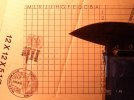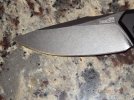This is a newbie question.
As far as I understand: With systems like Tsprof, Edge Pro, Wicked Edge, Madedge the arm is anchored at one point and if the blade would be completely straight then we'd get the same angle along the entire blade. But if the blade is not a straight line then on those parts that reach forward more there is a lesser angle than on those parts that do not reach as far forward from the jig. I hope the diagram better explains my question.
https://drive.google.com/file/d/1KncrScqO6y2sENMS4J49821MSJyQ6NgB/view?usp=sharing
The intended angle on the blade is 19.8°. The tip is set back from the edge by 5mm and the angle on the tip would be 20.17° if measured perpendicular to the straight part of the edge. That's not that much. But the edge at the tip has an angle in this example of 36.87° relative to the straight part of the edge. It then seems that the angle at the tip measured perpendicular to the edge at the tip would be 24.66° or almost a 5° difference to the straight part of the edge.
So, is this an appropriate model of what goes on? And if it is, how do you compensate for it?
As far as I understand: With systems like Tsprof, Edge Pro, Wicked Edge, Madedge the arm is anchored at one point and if the blade would be completely straight then we'd get the same angle along the entire blade. But if the blade is not a straight line then on those parts that reach forward more there is a lesser angle than on those parts that do not reach as far forward from the jig. I hope the diagram better explains my question.
https://drive.google.com/file/d/1KncrScqO6y2sENMS4J49821MSJyQ6NgB/view?usp=sharing
The intended angle on the blade is 19.8°. The tip is set back from the edge by 5mm and the angle on the tip would be 20.17° if measured perpendicular to the straight part of the edge. That's not that much. But the edge at the tip has an angle in this example of 36.87° relative to the straight part of the edge. It then seems that the angle at the tip measured perpendicular to the edge at the tip would be 24.66° or almost a 5° difference to the straight part of the edge.
So, is this an appropriate model of what goes on? And if it is, how do you compensate for it?


